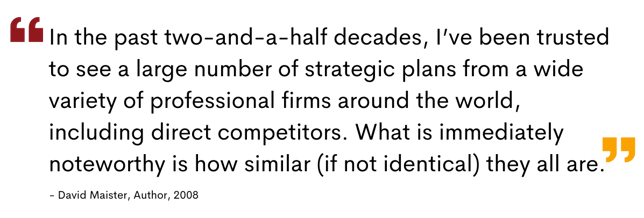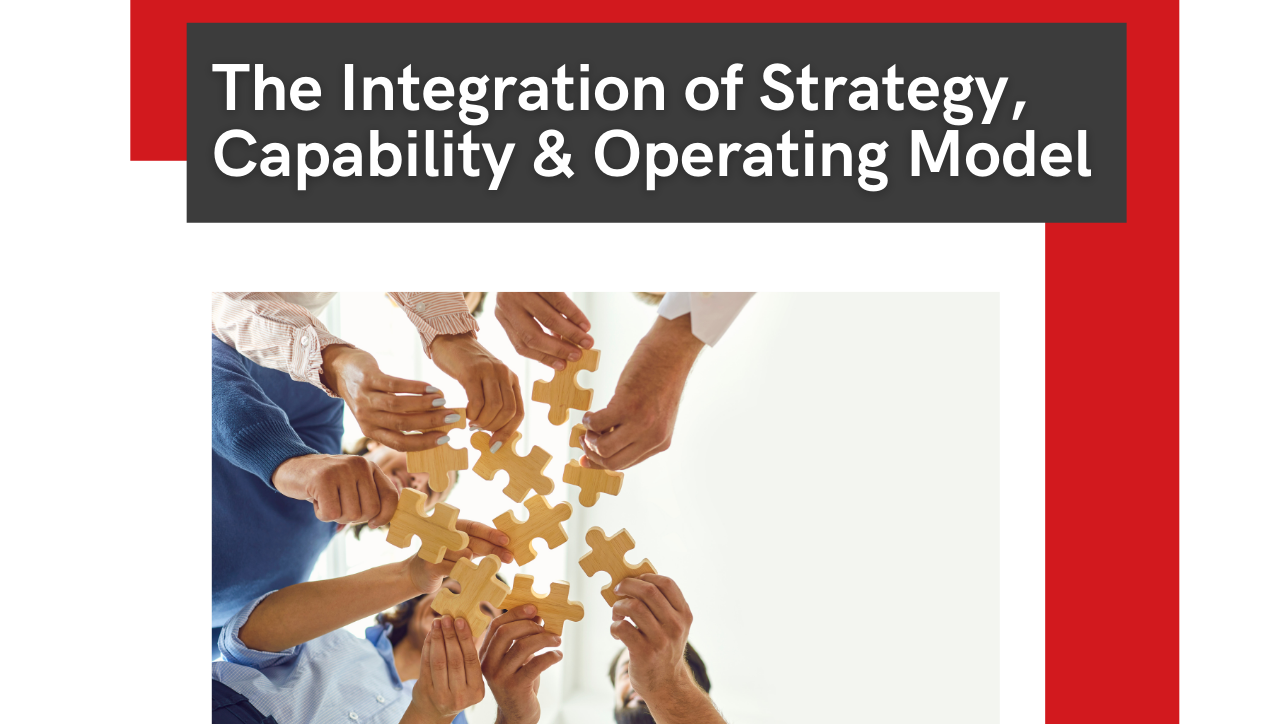6 minute read
Takeaway: In order to make strategy real, strategy must first be defined and agreed upon by those at the top. After strategy is defined, the core capabilities that enable a business to achieve its strategic choices must also be identified and integrated with the operating model. Without these two critical steps, strategy is only a good idea waiting to happen.

Pause for a moment and consider if you believe this leading remark.
What are the implications? It is not sufficient to have a well-articulated strategy if it does not then lead to aligned work activity. Only action can bring strategy to life.
Effective strategy is a set of choices in an integrated framework that runs from an organization’s aspiration (i.e., mission, vision) through core capabilities and into the operating model. To translate strategy into action a business must intentionally create an operating model aligned with the strategy.
If you agree with the message in this article, share it with your management team. The first step to effective strategy is adopting the same framework to facilitate dialogue and shared understanding.
Strategy Is a Set of Mutually Reinforcing Choices
Strategy is a set of decisions intended to position an organization for a successful future in a competitive environment. In most cases, a successful future is defined by enduring profitability and/or longevity. Strategy directs activity toward these ends.
A useful and easily understood framework for strategy is consolidated by Martin and Laffley in Playing to Win (2013). They identify five levels of integrated strategic decisions. Choices made at each level must be interdependent and self-reinforcing with all other levels in the framework. I have broadened the fifth level considerably, so this model is presented as an adaptation of their original work.
-1.png?width=640&name=the%20integration%20of%20strategy%20and%20capability%20(2)-1.png)
This view of strategy shows the fundamental intention in a vertically integrated framework. It is not a plan of execution. It is a direction around which sense-making, decision making, and activity required to achieve the winning aspiration are aligned. It is purposefully high level. Organizations operate in competitive and rapidly changing environments that are not well aligned to highly specified strategic plans.
Core Capability Defines a Work System
Core capability is any critical work system that broadly enables a firm’s strategic choices. To be considered core capability, there are three key tests:
-1.png?width=643&name=the%20integration%20of%20strategy%20and%20capability%20(3)-1.png)
These criteria differentiate core capability from the many things a company must simply be good at. To quote Martin and Laffley, “There are a small number of activities that together create distinctiveness, underpinning specific where-to-play and how-to-win choices.” It is these distinctive competencies that focus investment choices for the company while reducing or optimizing investment in capability that is important but not critical to strategy. You focus on what matters most.
Choices about strategy and core capability are expected to guide the organization for many years to come. Shorter-term objectives that are consistent with the achievement of strategy are called strategic initiatives or strategic intent. It refers to objectives a firm will pursue to remain responsive to the changing environment and continue developing core capability. This distinction allows a firm to adjust and pursue strategy without continuously revisiting and changing its central features.
Your Operating Model Creates Core Capability
At some point, all grand strategies must necessarily degenerate into work. The work itself comes into play during the fifth step in the strategic framework. Your operating model is the link between strategic choices and the actual behavior of the firm. The operating model defines the work the firm will do, how it will organize and integrate that work, systems of reward and recognition, and people processes in levels of detail that may then be implemented. Step five consists of many more choices compared to the preceding steps and is commonly viewed through the Galbraith Star Model.
The design activity in step five cannot begin until leadership is clear and aligned about the first four steps of the strategic framework. These preceding steps define the criteria the future operating model must satisfy to create and deliver customer value.
An operating model is not easily copied by competitors. Returning attention to the opening quote, if strategies are generally similar, what makes one organization more successful than others?
You achieve competitive differentiation by delivering your core capability both consistently and at industry leading levels of performance. The activation of work and its integration into a cohesive operating model is very difficult to copy. Your strategy doesn’t differentiate, your operating model does.
Case: Capability to Commercialize Innovation
The following brief case illustrates the development of strategic capability in a company in which OTM has worked in the past.
In this organization, meaningful innovation occurred with unpredictable regularity. Recognizing the strategic value of innovation, leadership articulated product leadership as the primary value-creating strategy. This vision didn’t match the organization’s current state. The ability to consistently capture downstream value of innovation in the form of enterprise reputation, operational application, and licensing revenue was missing. Thus, creating capability to identify and commercialize innovation became a key design criterion in the organization redesign.
A design team articulated the desired outcomes it needed from this strategic capability, defined work activity and positioned it in the enterprise value stream. This work was then placed into boundaries within an overall enterprise concept. Implementation staffed jobs and further defined management mechanisms. Fine-tuning the design continued well into the stabilization phase.
.png?width=643&name=the%20integration%20of%20strategy%20and%20capability%20(5).png)
The design activity is straightforward but not easy. The act of building the capability is based in sound process of organization design.
Rethink Your Strategic Framework and Identify Core Capability
Strategy disconnected from the operating model is only words on paper.
The many competing views of strategy muddy the water. Strategy as mission, vision, and organization identity is not enough. Strategy as plan that isn’t focused by core capability is not enough. Strategy as a pattern of following the leader will not by itself lead your firm to sustainable success.
In your next strategy review, fit your prepared elements of your firm’s strategy into the framework articulated in this article.
Pay particular attention to what is defined as a core capability, the work systems that define a company and critically enable strategy. How many do you define? Do each pass the key tests? If not, you likely have a list of capabilities loosely connected to the framework of strategic choices that fail to differentiate the organization and focus investment. Review and refine these core capabilities.
Afterward, turn your attention to the operating model. Expand participation in this assessment to members both across functions and down the organization chart.
.png?width=645&name=the%20integration%20of%20strategy%20and%20capability%20(6).png)
At ON THE MARK, we call this step Current State Review and advise it as a regular business practice. With this view, you will have much data to decide what you want to do next, if anything.
Read Part 1 of Making Strategy Real: The Blog Series here.
Dan Schmitz is a Consultant at ON THE MARK.
OTM is the leading global boutique organization design consultancy with offices in the USA and UK. With over 450 successful redesigns and operating model modernizations completed, OTM is the owner of the industry’s most integrated, comprehensive, and holistic organization design solution. OTM enables its clients to realize their future ambitions.



.png?width=577&name=the%20integration%20of%20strategy%20and%20capability%20(4).png)
